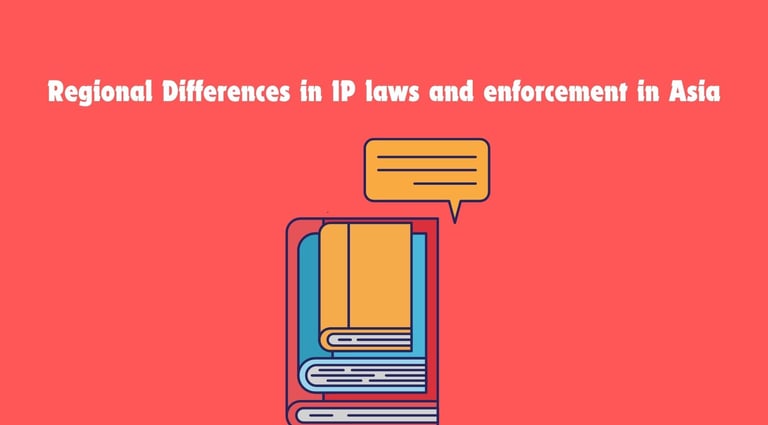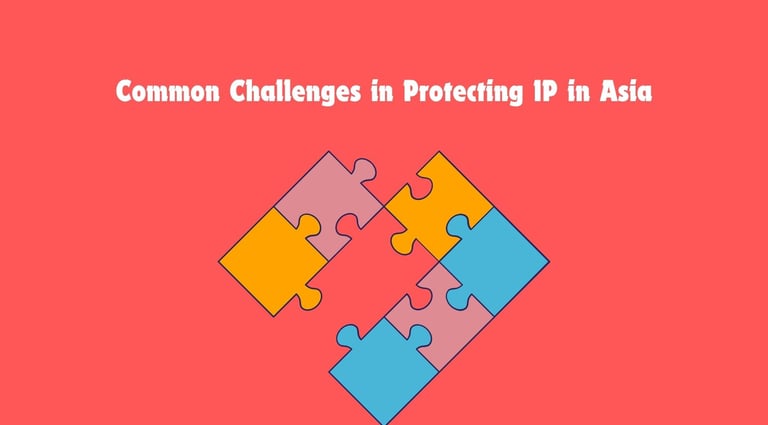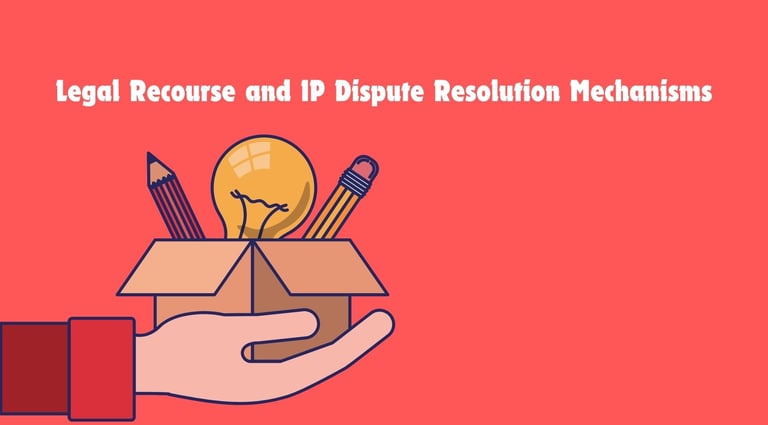Why is Intellectual Property Crucial for Business in Asia?
ASIA BUSINESS FACTSBUSINESS TIPS
Alan Wong
5/22/202418 min read


How Intellectual Property for Tech Companies Expanding in Asia?
Intellectual Property (IP) is a fundamental asset for businesses operating in Asia, a region renowned for its rapid economic growth and vibrant cultural industries.
Protecting IP is essential for maintaining a competitive advantage, fostering innovation, and ensuring long-term business sustainability.
In Asia, particularly in countries like Japan and South Korea, robust IP protection systems are in place to support businesses by safeguarding creative works, technological inventions, and brand identities, thereby facilitating business growth and business expansion.
IP protection in Asia allows companies to safely invest in research and development without the risk of their innovations being copied or misused.
This legal security promotes a healthy environment for creativity and technological advancement, allowing businesses to innovate confidently.
Furthermore, strong IP laws enhance the value of intangible assets, making businesses more attractive to investors and partners.
The role of IP in fostering innovation and creativity is particularly evident in Asian markets.
For instance, Japan's manga and anime industries and South Korea's K-Pop industry are global cultural phenomena, driven by strong IP protection that enables creators and businesses to monetize their creations effectively.
These industries not only contribute significantly to the economy but also set high standards for IP management and enforcement.
According to the World Intellectual Property Organization (WIPO), countries in Asia have made significant strides in creating robust IP systems that support innovation.
These countries continuously improve their IP laws and enforcement mechanisms to protect the interests of inventors and businesses, thereby fostering an environment conducive to creativity and technological advancement.
Legal Recourse and Intellectual Property (IP) Dispute Resolution Mechanisms
The mechanisms for legal recourse and dispute resolution in Asia vary significantly across different countries, reflecting the diverse legal systems and administrative structures in the region.
In countries like Japan and South Korea, the legal framework for IP protection is well-developed, with specialized IP courts and efficient judicial processes.
These courts are staffed by judges with expertise in IP law, ensuring that cases are handled with a high level of competence and efficiency.
Businesses can expect a relatively straightforward process for filing lawsuits, obtaining injunctions, and securing compensation for damages.
In China, while significant progress has been made in strengthening IP laws and establishing specialized IP courts, enforcement remains inconsistent, particularly at the local level.
However, the Chinese government has been actively working to improve the IP environment through reforms and increased penalties for infringements.
Foreign businesses often find it beneficial to work closely with local authorities and legal experts to navigate the system effectively and ensure that their IP rights are protected.
In Southeast Asia, countries like Singapore offer a robust IP protection framework with efficient dispute resolution mechanisms.
Singapore's Intellectual Property Office (IPOS) provides mediation services that offer a cost-effective and timely alternative to litigation.
Mediation allows parties to resolve disputes amicably with the help of a neutral mediator, often resulting in mutually agreeable solutions without the need for prolonged court proceedings.
Other countries in the region, such as Thailand and Indonesia, are still developing their IP enforcement capabilities.
Businesses operating in these markets may face challenges due to limited resources and varying levels of government commitment to IP protection.
In these cases, arbitration and mediation can be effective alternative dispute resolution mechanisms.
Organizations like the World Intellectual Property Organization (WIPO) offer arbitration and mediation services that are recognized internationally and can provide a neutral ground for resolving cross-border IP disputes.
Conclusion about Intellectual Property (IP) in Asia
In conclusion, the importance of intellectual property (IP) in driving business success in Asian Market cannot be overstated. IP protection is crucial for maintaining competitive advantage, fostering innovation, and ensuring long-term sustainability in a region renowned for its rapid economic growth and vibrant cultural industries.
Navigating the IP landscape in Asia requires a deep understanding of regional differences, emerging trends, and the strategic use of advanced technologies.
Businesses must be proactive in identifying and addressing IP infringements, utilizing legal recourse and dispute resolution mechanisms to protect their assets.
Successful brand collaborations, such as those involving K-Pop and Japanese manga, highlight the potential of well-managed IP in creating lucrative opportunities and expanding market reach.
Businesses are encouraged to prioritize IP protection in their strategies, recognizing it as a vital component for success in the dynamic Asian markets.
By securing their innovations and managing their IP assets effectively, companies can capitalize on the immense opportunities presented by Asia's burgeoning economy and cultural influence, ensuring sustained growth and a competitive edge.
With over 50 years of experience combined with our team at ToAsia.biz, we are ready to provide business consultation services to lead your business into the Asia Pacific region - profitably.
Talk to us now and see how our growth strategy is different from other business consultants out there where our focus is to help you expand at the right pace, staying lean and profitable.


Emerging Trends in Intellectual Property in Asia
The IP landscape in Asia is rapidly evolving, presenting several emerging trends that tech companies must navigate.
One notable trend is the increased focus on digital and technological innovations.
As digital transformation accelerates, countries are prioritizing the protection of software, digital platforms, and online content.
For instance, Japan has introduced amendments to its Copyright Act to address issues related to the digital use of copyrighted materials, ensuring that creators are adequately compensated for digital reproductions and distributions.
South Korea, known for its tech-savvy population and advanced digital infrastructure, has also been proactive in updating its IP laws.
The country has implemented measures to enhance the protection of software and digital content, reflecting the growing importance of these assets in the modern economy.
South Korea's amendments to its Patent Act now include provisions for software patents, recognizing the need to protect innovations in this rapidly evolving field.
Moreover, Asian countries are not only updating their laws but also strengthening their IP enforcement mechanisms to combat infringement more effectively.
For example, China has established specialized IP courts in Beijing, Shanghai, and Guangzhou, significantly improving the efficiency and consistency of IP litigation.
These courts are equipped with judges who have expertise in IP law, ensuring that cases are handled by knowledgeable professionals.
The region is also witnessing increased cooperation between government agencies to tackle IP infringement.
Enhanced border controls and stricter penalties for IP violations are being implemented to deter counterfeiters and protect legitimate businesses.
This is particularly evident in the efforts of the Association of Southeast Asian Nations (ASEAN), where member countries are collaborating to improve IP enforcement through joint operations and information sharing.
Additionally, there is a growing trend of international collaboration in IP protection.
Asian countries are engaging in bilateral and multilateral agreements to harmonize IP laws and enforcement practices.
For example, the Comprehensive and Progressive Agreement for Trans-Pacific Partnership (CPTPP) includes several Asian countries and aims to standardize IP protection across its member states, facilitating easier cross-border IP management for tech companies.
Tech companies expanding into Asia must stay informed about these developments to effectively safeguard their IP assets and capitalize on the opportunities presented by this dynamic market.


Impact of AI and Blockchain on Intellectual Property (IP) Protection
Technological advancements are significantly reshaping IP protection in Asia, particularly through the adoption of emerging technologies like artificial intelligence (AI) and blockchain.
AI is being harnessed to enhance the efficiency and accuracy of patent searches, trademark examinations, and copyright enforcement.
By leveraging AI-powered tools, businesses and regulatory authorities can identify potential IP infringements more quickly and accurately than with traditional methods.
AI algorithms can analyze vast amounts of data, enabling the swift detection of unauthorized use of intellectual property and ensuring timely action against infringers.
Singapore is at the forefront of incorporating advanced technology into IP protection.
The Intellectual Property Office of Singapore (IPOS) has launched an AI-powered patent search system that significantly reduces the time needed to conduct thorough patent searches.
This system, known as the "IP2SG" platform, allows for more efficient and accurate identification of existing patents, thereby enhancing the protection of new innovations.
Blockchain technology is revolutionizing the management and enforcement of IP rights.
By providing a transparent and immutable record of IP ownership and transactions, blockchain helps prevent counterfeiting and ensures the integrity of IP assets.
For instance, Japan has been exploring the use of blockchain for patent management and IP rights tracking, creating a more secure system for verifying IP ownership and transfer.
Similarly, South Korea's Ministry of Science and ICT is experimenting with blockchain to manage and track IP rights, aiming to establish a more transparent and secure framework for IP protection.
India is making strides as well, with initiatives to incorporate blockchain technology into its IP infrastructure.
The Indian Patent Office is exploring blockchain applications for maintaining transparent and secure records of patent applications and grants.
This initiative aims to improve the reliability and efficiency of the patent registration process, ensuring that inventors and businesses can protect their IP rights more effectively.
In Southeast Asia, countries like Thailand and Malaysia are increasingly leveraging big data and analytics to bolster their IP enforcement efforts.
These technologies help monitor IP usage and identify trends in infringement, allowing businesses and regulatory authorities to proactively address potential violations.
By analyzing patterns and detecting anomalies, big data tools provide insights into IP infringement activities, helping stakeholders develop effective strategies to safeguard their intellectual property.
Overall, the integration of AI, blockchain, and big data into IP protection processes is transforming the way intellectual property is managed and enforced in Asia.
These technological advancements are enhancing the efficiency, transparency, and security of IP systems, enabling businesses to better protect their innovations and maintain a competitive edge in the rapidly evolving market.


Regional Differences in Intellectual Property (IP) laws and enforcement in Asia
The landscape of intellectual property (IP) laws and enforcement varies significantly across Asia, reflecting the diverse legal traditions, economic priorities, and administrative capacities of different countries.
In Japan, the IP system is highly advanced and sophisticated, with comprehensive laws and a strong enforcement mechanism.
The Japan Patent Office (JPO) is known for its efficiency and thorough examination process. Additionally, Japan has specialized IP courts that handle disputes swiftly and effectively, providing robust protection for IP owners.
South Korea also boasts a strong IP framework, supported by the Korean Intellectual Property Office (KIPO).
South Korea is particularly noted for its rigorous enforcement against counterfeit goods and digital piracy.
The country's IP laws are continuously updated to address emerging issues, reflecting its dynamic tech and entertainment industries.
In Southeast Asia, countries like Singapore and Malaysia have made considerable strides in enhancing their IP regimes.
Singapore, for instance, is a regional leader with a highly efficient and transparent IP system managed by the Intellectual Property Office of Singapore (IPOS).
Singapore’s legal framework is designed to be business-friendly, making it an attractive destination for international companies seeking strong IP protection.
On the other hand, countries like Indonesia and Vietnam are still developing their IP systems.
While they have made significant progress, enforcement can be challenging due to limited resources and varying levels of government commitment.
These countries are working on improving their IP infrastructure and enforcement capabilities to attract more foreign investment and promote innovation.


Common Challenges in Protecting Intellectual Property (IP) in Asia
Protecting intellectual property in Asia comes with several challenges, including inconsistent enforcement, cultural differences, and the prevalence of counterfeit goods.
One of the primary challenges is the variation in enforcement efficacy across different countries.
While some nations have robust systems, others struggle with inadequate resources and lack of trained personnel, making it difficult to ensure consistent IP protection.
Counterfeiting and piracy are pervasive issues in many Asian markets.
Countries like China and India have high incidences of counterfeit goods, which can severely impact businesses, particularly those dealing in luxury goods, pharmaceuticals, and electronics.
Despite stringent laws, enforcement remains a challenge due to the sheer scale of the problem and the sophisticated methods employed by counterfeiters.
Cultural differences also play a role in IP challenges. In some parts of Asia, the concept of IP is not as deeply ingrained as it is in Western countries.
This can lead to less respect for IP rights among consumers and businesses, complicating enforcement efforts.


Best Practices for Intellectual Property (IP) Management in Asian Markets
To navigate these challenges, businesses should adopt best practices for IP management.
One crucial strategy is to register IP rights in each country where they operate, ensuring legal recognition and protection.
Companies should also engage local legal expertise to navigate the complex IP landscape and understand the nuances of local laws and enforcement practices.
Building strong relationships with local authorities and industry associations can also aid in better enforcement and protection of IP rights.
Regular monitoring and auditing of the market for potential infringements are essential, allowing companies to take swift action against violators.
Utilizing technology such as AI and blockchain can enhance the monitoring and enforcement process, providing more robust protection against IP theft and counterfeiting.
Moreover, businesses should invest in educating local partners, employees, and consumers about the importance of IP rights.
Raising awareness can foster a culture of respect for IP and reduce the incidence of infringement.
By implementing these best practices, companies can better protect their intellectual property and ensure their innovations are safeguarded across the diverse and dynamic markets of Asia.


Intellectual Property (IP) Infringements in Asia
Intellectual property (IP) infringements are a significant concern for businesses operating in Asia, given the region's diverse legal landscapes and varying levels of enforcement rigor.
Identifying and addressing these infringements effectively is crucial for maintaining the integrity of IP assets and ensuring that companies can capitalize on their innovations without undue interference.
Identifying IP infringements in Asia requires a proactive approach, leveraging both technology and local expertise.
Businesses must implement robust monitoring systems to track the use of their IP across various platforms and markets.
This includes online surveillance to detect unauthorized digital content distribution, counterfeit product listings, and improper use of trademarks.
Businesses should engage local partners and legal experts who understand the specific IP landscape of each country.
These local experts can provide insights into common infringement practices and help businesses navigate the complexities of local laws and enforcement procedures.
For example, local legal firms can conduct market surveys and investigations to uncover counterfeit operations and provide evidence for legal actions.
Once an infringement is identified, addressing it promptly is essential.
This typically involves sending cease-and-desist letters to the infringers, demanding that they stop the unauthorized use of the IP and remove any infringing products or content.
In more severe cases, businesses may need to pursue legal action to protect their rights.
This can include filing lawsuits in civil courts, seeking injunctions to halt the sale of counterfeit goods, and demanding compensation for damages.




What are the Types of Intellectual Property?
Intellectual Property (IP) encompasses a range of legal protections designed to secure the unique creations of the human mind.
These protections allow creators and inventors to control and benefit from their work. Understanding the different types of IP is essential for businesses and individuals seeking to protect their intellectual assets effectively. The primary types of IP include trademarks, copyrights, patents, and trade secrets.
Types of Intellectual Property (IP): Trademarks for Brand Identity Protection
Trademarks are distinctive signs or symbols used by a business to identify its goods or services and distinguish them from those of others.
These signs can include logos, slogans, brand names, and even distinctive packaging or shapes.
The primary function of a trademark is to protect the brand identity of a company, ensuring that consumers can reliably identify and purchase products from a particular source without confusion.
For instance, iconic logos such as Nike’s swoosh or Apple’s apple symbol are trademarks that immediately convey the brand's identity and quality.
Trademark protection prevents other businesses from using similar signs that could mislead consumers.
In addition to logos and brand names, trademarks can also protect non-traditional elements like colors, sounds, and smells if they are distinctive enough to identify the product's origin.
Obtaining trademark protection involves registering the trademark with the relevant government authority, such as the United States Patent and Trademark Office (USPTO) or the Intellectual Property Office of Singapore (IPOS).
Once registered, the trademark owner has exclusive rights to use the mark and can take legal action against anyone who uses it without permission.


Types of Intellectual Property (IP): Copyrights for Safeguarding Creative Works
Copyrights protect original works of authorship, including literary, musical, and artistic works, as well as films, software, and architectural designs.
Copyright gives the creator exclusive rights to reproduce, distribute, perform, display, and create derivative works based on the original.
This protection ensures that creators can control how their work is used and can financially benefit from their creations.
For example, in Asia, Japanese manga, South Korean K-pop, and Webtoon are iconic cultural phenomena protected by copyright.
When a manga artist creates a new series, the copyright on their drawings and storylines allows them to control who can reproduce, distribute, and adapt their work.
This means that unauthorized copies or adaptations, whether in print or digital format, are illegal.
Manga artists can license their works to publishers, merchandise manufacturers, and film studios, ensuring that they receive royalties and maintain control over how their creations are used.
Similarly, in the K-Pop industry, songs, music videos, and performances are protected by copyright.
A K-Pop band's music, choreography, and visual content are all original works of authorship.
The copyright on these creations allows the artists and their management companies to control who can use their music and videos, whether for performances, merchandise, or advertisements.
Unauthorized use of a K-Pop song or video without permission constitutes copyright infringement, and the copyright owners can take legal action to enforce their rights.
The copyright owner can license the work to others, allowing them to use it under specific conditions, or can sell the rights altogether.
Copyright protection is automatic upon the creation of the work, but registering the copyright with the appropriate government agency, such as the Japan Copyright Office (JCO) or the Korean Copyright Commission (KCC), can provide additional legal benefits.
These benefits include the ability to sue for statutory damages and attorney’s fees in case of infringement, which strengthens the enforcement of copyright protections.
Copyright protection lasts for the lifetime of the creator plus an additional 50 to 70 years after their death, depending on the jurisdiction.
This long duration ensures that the creator and their heirs can benefit from the work for an extended period, providing a lasting legacy and continuous financial returns from their creative endeavors.
For instance, the creators of famous manga series and K-Pop songs continue to receive benefits from their works long after the initial release, ensuring that their contributions to cultural heritage are recognized and rewarded over time.


Types of Intellectual Property (IP): Patens for Securing Innovations and Inventions
Patents provide protection for new and useful inventions, including processes, machines, manufactures, and compositions of matter.
A patent grants the inventor exclusive rights to make, use, sell, and import the invention for a limited period, typically 20 years from the filing date of the patent application.
This exclusivity incentivizes innovation by allowing inventors to recoup their investment in research and development.
For example, a SaaS (Software as a Service) company that develops a novel software platform can obtain a patent to prevent others from using, selling, or importing the software without permission.
This monopoly enables the company to set prices that reflect the costs of development and provide a financial return on their investment.
To obtain a patent, the company must file a detailed application with the relevant patent office, such as the Japan Patent Office (JPO) or the Intellectual Property Office of Singapore (IPOS).
The application must demonstrate that the invention is novel, non-obvious, and useful.
Patents are particularly crucial in technology-driven industries where innovation is rapid, and the competitive advantage gained from new inventions can be significant.
For example, a patented algorithm that significantly improves data processing speeds or security protocols can provide a substantial competitive edge in the software market.
The protection granted by patents allows the SaaS company to maintain this edge by preventing competitors from replicating their technology.
Moreover, patents can enhance the company's market position and attract investment.
Investors are more likely to fund businesses that have secured their innovations, knowing that the company has exclusive rights to its technology.
This can be particularly advantageous in the fast-paced tech industry, where new innovations continually emerge.
However, once the patent expires, the invention enters the public domain, allowing others to use and build upon it.
This expiration encourages continuous innovation and dissemination of knowledge, contributing to overall technological advancement.
For the SaaS company, this means that while they enjoy a period of exclusivity, they must also continually innovate to maintain their market position once the patent protection ends.


Types of Intellectual Property (IP): Trade Secrets for Confidential Business Information
Trade secrets encompass confidential business information that provides a competitive edge.
Unlike other forms of IP, trade secrets are protected not through registration but through maintaining their secrecy.
This information can include formulas, practices, designs, instruments, patterns, or any information that is not generally known and that a business takes reasonable steps to keep confidential.
A famous example of a trade secret is the formula for Coca-Cola.
The company has kept this formula secret for over a century, providing a significant competitive advantage.
To qualify as a trade secret, the information must have commercial value because it is secret, and the business must take reasonable measures to protect its confidentiality, such as implementing security protocols and requiring non-disclosure agreements (NDAs) from employees and partners.
The protection of trade secrets continues indefinitely as long as the information remains confidential and provides a competitive advantage.
However, if the secret is independently discovered, reverse-engineered, or leaked, the protection is lost.
Unlike patents, trade secrets do not expire, making them a valuable form of IP for certain types of information.
Understanding these various forms of IP protection is essential for businesses and individuals to safeguard their intellectual assets effectively.
By leveraging the appropriate IP protections, creators and inventors can ensure their innovations and creations are secure, enabling them to benefit from their work and maintain a competitive edge in the market.


Leveraging Pop Culture Intellectual Property (IP) for Business Success in Asia
Asia's pop culture has become a global phenomenon, impacting various industries and generating substantial business opportunities.
Businesses can achieve remarkable success by harnessing this cultural wave and engaging with the extensive and enthusiastic fanbases of iconic cultural products such as Japanese manga and South Korean K-Pop.
These cultural exports have transcended national boundaries to become staples in global entertainment.
Series like "Dragon Ball", "Naruto," "One Piece," and "Attack on Titan" have amassed millions of fans worldwide, creating lucrative markets for related merchandise, video games, and adaptations.
In a similar vein, South Korean K-Pop has grown into a cultural powerhouse.
Groups such as BTS and BLACKPINK have achieved immense popularity on a global scale, influencing music, fashion, and lifestyle trends and shaping consumer behavior.
Their broad appeal makes them valuable partners for brands aiming to enhance their market presence.
To succeed in leveraging this cultural influence, businesses must understand the profound impact of Asian pop culture, examine successful brand collaborations, and appreciate the critical role of intellectual property (IP) in these partnerships.
Recognizing and managing IP effectively ensures that collaborations are legally sound and beneficial for all parties involved, fostering innovation and sustained cultural impact.


Successful Case Studies of Intellectual Property (IP) and Brand Collaborations in Asia
Several brands have successfully collaborated with Asian pop culture entities to create compelling marketing campaigns and boost their visibility.
A notable example is the collaboration between McDonald's localization and BTS.
In 2021, McDonald's launched the "BTS Meal," featuring the band's favorite menu items and exclusive packaging.
This collaboration was a massive success, driving significant sales increases and global social media engagement.
The campaign's success underscored the immense influence of K-Pop and its potential to drive consumer behavior.
Another example is the partnership between Uniqlo and the manga series "One Piece."
Uniqlo released a special line of T-shirts featuring designs from the popular series.
This collaboration resonated with fans and boosted Uniqlo's sales, demonstrating how leveraging popular manga can enhance a brand's appeal and reach.
Netflix's "Squid Game" is another prime example of leveraging pop culture for business success.
The South Korean series became a global sensation, breaking viewership records and sparking worldwide discussions.
Brands capitalized on the show's popularity through various means, such as themed merchandise, partnerships, and marketing campaigns that referenced its iconic imagery and themes.
This phenomenon highlights how powerful a successful cultural product can be in creating opportunities for brand engagement and sales.
In the gaming industry, Nintendo's collaboration with various anime series for its game adaptations has been highly successful.
Games like "Pokémon," which originated as a video game series, have seamlessly integrated with anime to create a multimillion-dollar franchise encompassing games, TV shows, movies, and merchandise.
This cross-platform synergy exemplifies the potential of leveraging pop culture for expansive business growth.
The success of these collaborations hinges on the strategic use of intellectual property (IP).
Ensuring that IP rights are respected and effectively managed is crucial for both the creators and the collaborating brands.
Proper IP management ensures that creators receive due recognition and compensation for their work, which in turn fosters further creativity and innovation.
Leveraging pop culture in Asia for business success requires a deep understanding of its global influence, strategic partnerships, and meticulous management of intellectual property.
By effectively integrating these elements, businesses can tap into the vast potential of Asian pop culture, driving growth and creating enduring connections with consumers worldwide.


Alan Wong is founder of ToAsia.biz and a startup mentor with over 20 years of professional experience managing software, Saas and consulting services MNCs.
About Author
Copyright © 2025 ToAsia.biz


We lead your business to Asia
Our Business Growth Experts help SaaS businesses achieve growth in Asia and become profitable FAST.
Send us a message via WhatsApp
